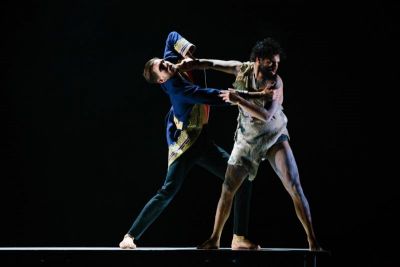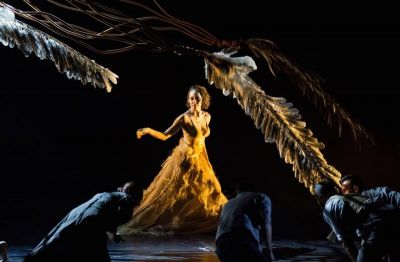Our Land People Stories
Evocative, challenging and often indescribably beautiful, Bangarra’s Our Land People Stories has lost none of its power since its debut in 2016. The collection of three works, from three different choreographers, range from political to spiritual – but always driven by the indigenous spirituality linked to Country and reverence for the land.
Jasmin Sheppard shows her incredible talent as a choreographer as well as a dancer in her debut work MacQ, based on Lachlan Macquarie and the 1816 Appin massacre. It’s a visceral work which starts with Sheppard herself as an indigenous woman mourning the death of her partner. The aura of grief is palpable as Sheppard wails, wraps lifeless limbs around her, attempts to will life back into the dead man. She is quite breath-taking, and we are immediately confronted with the overwhelming sense of loss that death brings to any culture of any colour. It is universal storytelling made even more tragic as history and context unfolds. One shouldn’t under-estimate the work of Luke Currie-Richardson as the dead man. He brings fluidity, grace and real credibility to the lifeless man – though that may seem a contradiction in terms. But it is in Lachlan Macquarie himself, that Sheppard is the most confronting. She shows us one man, flawed, desperately clinging to power, knowingly making mistakes and justifying them, creating his own torture.
 Daniel Riley’s dancing is perfection. His energy extends far beyond his physical presence. One can’t buy or manufacture charisma. You either have it or you don`t, and Riley wears it like a second skin. Sheppard choreographs to his strengths and uses it in the storytelling as much as the actual dance. Macquarie holds the power – and abuses it. The piece called “Territory”, danced by Riley and his cousin Beau Dean Riley Smith (a dancer of great strength and lyrical beauty) is astonishingly sophisticated and yet tribal. Both men astonish with their athleticism and dance skills. The power between the Governor and his tribal counterpart is delicately balanced, with each battling for the upper hand. It’s a strong portent of how history might have been different if Colonialism had been able to embrace what was part of the land without being so afraid, that it was imperative to crush it. Riley’s work throughout is exemplary, but it takes nothing away from the entire company. Every dancer has finely honed skills that are used to perfection. “Bodies In The Trees” is a breath-taking portrayal of the indigenous men who were hanged in the massacre. The patterns the bodies make as they seem suspended in mid air, swaying in the wind, defy explanation.
Daniel Riley’s dancing is perfection. His energy extends far beyond his physical presence. One can’t buy or manufacture charisma. You either have it or you don`t, and Riley wears it like a second skin. Sheppard choreographs to his strengths and uses it in the storytelling as much as the actual dance. Macquarie holds the power – and abuses it. The piece called “Territory”, danced by Riley and his cousin Beau Dean Riley Smith (a dancer of great strength and lyrical beauty) is astonishingly sophisticated and yet tribal. Both men astonish with their athleticism and dance skills. The power between the Governor and his tribal counterpart is delicately balanced, with each battling for the upper hand. It’s a strong portent of how history might have been different if Colonialism had been able to embrace what was part of the land without being so afraid, that it was imperative to crush it. Riley’s work throughout is exemplary, but it takes nothing away from the entire company. Every dancer has finely honed skills that are used to perfection. “Bodies In The Trees” is a breath-taking portrayal of the indigenous men who were hanged in the massacre. The patterns the bodies make as they seem suspended in mid air, swaying in the wind, defy explanation.
Music by David Page, both alien and yet familiar to our ears, is eerily seductive and Jacob Nash’s set, the long table, the accoutrements of Colonial wealth versus the stark open-ness of the land, combine perfectly with Matt Cox’s excellent lighting design. This is 25 minutes of theatrical perfection.
 If I have focussed in the majority on MacQ, it is because it is the most contentious of the three works, and the most political, and therefore the most challenging for a largely non-indigenous audience. But that takes nothing away from the other two works. Miyagan – Daniel Riley and Beau Dean Riley Smith’s homage to kin, is an almost ethereal work of strength and fragility, beautiful in both conception and execution. It’s touching and creates an amazing sense of connection between dancers and audience.
If I have focussed in the majority on MacQ, it is because it is the most contentious of the three works, and the most political, and therefore the most challenging for a largely non-indigenous audience. But that takes nothing away from the other two works. Miyagan – Daniel Riley and Beau Dean Riley Smith’s homage to kin, is an almost ethereal work of strength and fragility, beautiful in both conception and execution. It’s touching and creates an amazing sense of connection between dancers and audience.
The second half of the performance is given over to Nyapanya, Stephen Page’s tribute to Indigenous artist Nyapanyapa Yunupingu. We’re reminded yet again, even though he is no longer dancing, what an absolute gift Page is to the world of dance, indigenous or otherwise. Steve Francis’ music and soundscape perfectly blends the old and the new and creates an “other-world” effect that sits comfortably with more recognisable, though jarring, contemporary music. Elma Kris brings her superb lines to Nyapanyapa herself. It’s impossible to take your eyes off her. Waangenga Blanco, a dancer of enormous presence and identity, commands us to suspend disbelief as we watch him as The Buffalo, encountering the child Nyapanyapa, and the dancing of all the male dancers in the piece called Poles, reminds us that strength and lyricism combine beautifully.
This is a company of exemplary agenda and extraordinary talent whose quest for excellence is every bit as committed as its dedication to truth. Very few companies can mesmerise international, urban and rural audiences and bring us together in the way that Bangarra does. If you haven’t experienced Bangarra Dance Theatre yet, ask yourself “Why on earth not?”
Coral Drouyn
Bangarra Dance Ensemble in Nyapanyapa; Daniel Riley & Beau Dean Riley Smith in Macq; Deborah Brown in Miyagan. Photographer: Vishal Pandey (2)
Subscribe to our E-Newsletter, buy our latest print edition or find a Performing Arts book at Book Nook.

